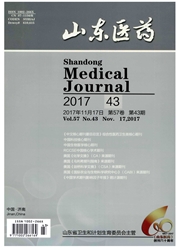

 中文摘要:
中文摘要:
目的构建不同片段的NPMl与绿色荧光蛋白(EGFP)的真核融合表达质粒,检测其在人乳腺癌MDA-MB-231细胞中的表达和定位。方法RT-PCR法从人乳腺癌MDA-MB231细胞cDNA中扩增不同片段的NPM1,产物经电泳分离、切胶纯化后,分别采用XhoI和EcoRI进行酶切,然后与同样酶切后的pEGFP-C3载体进行连接反应,将连接产物转化大肠杆菌感受态细胞,挑取克隆,提取质粒并酶切鉴定。将酶切及测序鉴定后的pEGFP/NPM1质粒采用脂质体介导后将其转入MDA-MB-231细胞中,通过Westernblot技术检测其蛋白的表达。倒置荧光显微镜观察其亚细胞定位。结果酶切鉴定和基因测序结果显示不同片段的pEGFP-NPM1融合表达质粒构建成功,并可在MDA-MB-231细胞内表达,倒置荧光显微镜下可以清晰显见融合蛋白的亚细胞定位。结论NPM1及其不同结构域的真核重组质粒构建成功,在细胞中成功表达,并可以用于分析其亚细胞定位,从而为进一步研究NPM1在乳腺癌发生发展中的作用奠定基础。
 英文摘要:
英文摘要:
Objective To construct recombinant plasmid pEGFP-NPM1 and detect its expression and location in hu- man breast cancer cell line MDA-MB-231. Methods RT-PCR method was performed to amplify the entire fragment of NPM1 gene, the amplified NPM1 gene was inserted into eukaryotic expression vector pEGFP-C3 to construct pEGFP/NPM1 recombinant plasmid, and transfected into MDA-MB-231 cells by lipofectamine mediated gene transfection. The efficiency of transfection and distribution were determined by microscopy. Results The recombinant plasmid was identical as expec- ted. The fusion protein was expressed in MDA-MB-231 cells. The green fluorescence of the protein could be observed by confocal laser microscope. Condusions The encoding sequence of NPM1 gene and its different domain can be successful- ly cloned into the expressive vector and expressed in MDA-MB-231 cells, and analyze subcelluar location. The function of NPMI protein can be used to further medical study.
 同期刊论文项目
同期刊论文项目
 同项目期刊论文
同项目期刊论文
 Identification of the Interaction between P-Glycoprotein and Anxa2 in Multidrug-resistant HumanBreas
Identification of the Interaction between P-Glycoprotein and Anxa2 in Multidrug-resistant HumanBreas 期刊信息
期刊信息
